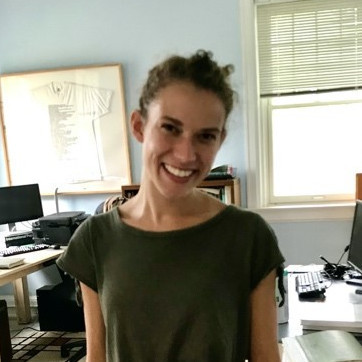
Katherine Franz, Summer 2020 Laumeier Sculpture Park in St. Louis
Woodhenge (2016) by Gigi Scaria is one of many favorite sculptures at Laumeier. Inspired by the nearby
Cahokia Mounds State Historic Site and the modern cities of St. Louis and New Delhi, the piece
examines the abandonment of urban civic constructs in the wake of suburban sprawl.
A summer spent at home afforded me the opportunity to return to a special place located
nearby: Laumeier Sculpture Park in St. Louis. As someone who frequented the park and
participated in many of Laumeier’s summer outdoor art programs growing up, the chance to
work as an intern under the supervision of Curator of Exhibitions Dana Turkovic provided me a
new perspective on the organization and the various artists connected to it.
A 105-acre land with more than 70 large-scale outdoor sculptures, Laumeier is uniquely
situated at the nexus between a museum and a park, a curated garden and a natural landscape, a
place where sculptures are conserved and where art is allowed to be changed by nature-- rusted,
ruined and refurbished-- realizing a second or a fifth life. Fitting to the site, many artworks have
humans’ relationship with the landscape as a central theme.
For example, one task I was involved with was assisting the park preparators in the
deinstallation of Follies, a temporary exhibition by Mark Dion that ran from February until May.
The exhibition consisted of shed-like sculptures filled with various objects and specimens that
showed processes of collection, classification, and occasionally exploitation associated with the
endeavor of scientists and naturalists to study and make sense of the world around them. In
addition to expanding my practical skills in museum registrar responsibilities like photography
and object deacquisition, handling the pieces prompted reflection on the moral dimensions of
exploration within my own areas of study, anthropology and environmental science.
Another primary responsibility throughout the summer was digitizing archived artist files
stored in the museum library in order to create a computer database. I learned to identify
documents such as artistic agreements, correspondence, object information, finances, and press
releases, and as a result gained a better understanding of the art exhibition process and of
working with archival material. By reading the work of my supervisor Dana Turkovic, I also had
the opportunity to see how curators can bring different works into conversation through the
power of exposition and creative writing.
The subjective human experience is at the heart of anthropology, and the sculptures at
Laumeier have shown me one way through which imaginative perspectives can be shared. I’m
grateful for the chance to have engaged with my love of art and nature in a space so familiar.